292. Once again. The Julian equinox (*84) was
perhaps considered as a kind of Janus point,
a final of the old in darkness combined with
another kind of darkness with light ahead, like the
renewal face of the Moon.
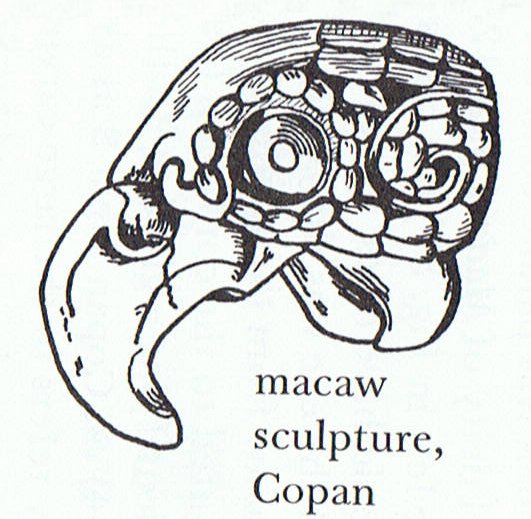
... Janus was perhaps not originally
double-headed: he may have borrowed this
peculiarity from the Goddess herself who at
the Carmentalia, the Carmenta
Festival in early January, was addressed by
her celebrants as 'Postvorta' and
'Antevorta' - 'she who looks both back and
forward' ...
|
Ira: |
|
Nga Kope Ririva Tutuu Vai A
Te Taanga (*72) |
|
... Possibly the time of
midnight (a Janus point)
should be illustrated with a
pair of glyphs. However,
Castor at 113.4 - 41.4 =
*72.0 would have risen with
the Sun around 6 a.m. in
July 12 (193 = 152 + 41)
with ¼ of him belonging in
day 194. I.e. day *73 at the
time of Bharani corresponded
to how March 14 (3-14 →π)
was day 73 counted from
January 1. 73 + 80 = 153 =
194 - 41. |
|
Te Maro 1 (80 + 360 / 5)
"June 1 (152 = 193 -
41) |
 |
 |
|
July 12 (193) |
13 (*114) |
|
CASTOR (α
Gemini, 113.4 = 41.4 + 72.0) |
|
Which means
the ihe tau glyph

could
represent the last quarter
of the day of Castor as
measured (at the time of
rongorongo) for the (true
heliacal) time of sunrise.
Notably the Arabs had in
their structure primarily
chosen heliacal stars with
the fraction 41.4 - 41 = 0.4
(= 12 * 12 / 360) ... |
 |
|
MUSCA
BOREALIS |
35 (Head of the Fly), 39
(Kaffaljidhma), and
41 Arietis (Bharani) |
41.4 |
May 1 (121) |
|
Al Dabarān |
Follower |
α Tauri (Aldebaran), θ¹,
θ²´,
γ (Hyadum I),
δ (Hyadum II), ε (Ain) |
63.4 |
May 23 (143) |
|
Al Hak'ah |
White Spot |
λ
Orionis (Heka),
φ¹,
φ² |
83.4 |
June 12 (163) |
|
Al Han'ah |
Brand |
γ Gemini (Alhena), μ
(Tejat Posterior), ν,
η (Tejat Prior),
ξ (Alzirr) |
93.4 |
June 22 (173) |
|
Al Dhirā' |
Forearm |
α Gemini (Castor),
β (Pollux) |
41.4 + 72 |
July 12 (193) |
|
BRIGHT FIRE |
χ Cancri (125.2),
and
λ Cancri (Bright Fire)
(125.4) |
41.4 + 84 |
July 24 (205) |
|
Al Nathrah |
Gap |
ε Cancri (Beehive) |
41.4 + 89 |
July 29
(420 / 2) |
|
Makoi:
 |
|
Hanga Te Pau (*80) -
ko te tomonga o Ira. |
|
Te Pu Mahore (*85) - a
Hau Maka (o Hiva). |
|
Te Maro 10 (80 + 400
/ 5) |
Te Maro 14 (80 +
420 / 5) |
 |
 |
 |
 |
|
Ga2-28 |
Ga2-29 |
Ga3-2 (61) |
Ga3-3 |
|
ρ
Puppis
(122.0),
HEAP OF FUEL = μ Cancri
(122.1), ζ Monocerotis
(122.3),
ψ
Cancri
(122.6),
REGOR (the astronaut
Roger mirrored) = γ
Velorum
(122.7) |
TEGMINE = ζ Cancri
(123.3) |
χ Cancri
(125.2),
BRIGHT FIRE
=
λ Cancri (125.4)
*84 = *125.4 - *41.4 |
AVIOR = ε Carinae
(126.4),
φ Cancri
(126.8) |
|
July 21 (*122) |
22 / 7 → π |
July 24 (*125) |
25 (206) |
|
ST JOHN'S DAY |
'June 25 (*96) |
'June 27 (178) |
28 (*126 - *27) |
|
"June 10 (161 = 202 -
41) |
11 |
"June 14 (164 = 205 -
41) |
15 (206 - 41) |
|
Pau.
1. To run
out (food, water):
ekó pau te kai, te vai,
is said when there
is an abundance of food
or water, and there is
no fear of running out.
Puna pau, a small
natural well near the
quarry where the 'hats'
(pukao) were
made; it was so called
because only a little
water could be drawn
from it every day and it
ran dry very soon. 2.
Va'e pau, clubfoot.
Paupau: Curved.
Vanaga.
1.
Hakapau, to pierce
(cf. takapau, to
thrust into). Pau.:
pau, a cut, a wound,
bruised, black and blue.
2. Resin. Mq.: epau,
resin. Ta.: tepau,
gum, pitch, resin.
(Paupau) Hakapaupau,
grimace, ironry, to
grin. 3. Paura
(powder), gunpowder. 4.
Pau.: paupau,
breathless. Ta.:
paupau, id. 5. Ta.:
pau, consumed,
expended. Sa.: pau,
to come to an end. Ma.:
pau, finished. 6.
Ta.: pau, to wet
one another. Mq.: pau,
to moisten. Churchill.
Paua
or
pāua
is the Māori name
given to three species
of large edible sea
snails, marine gastropod
molluscs which belong to
the family Haliotidae
(genus Haliotis),
known in the USA as
abalone, and in the UK
as ormer shells ...
Wikipedia |
Mahore.
A fish
(small,
silver-coloured).
Vanaga.
Ta.:
mahore, to peel off.
Sa.: mafoe, to be
skinned. Ma.: mahore,
to be peeled. Churchill.
... The dream soul of
Hau Maka continued
her journey and went
ashore on the (actual
Easter) Island. The
dream soul saw the fish
Mahore, who was
in a (water) hole to
spawn (?), and she named
the place 'Pu Mahore
A Hau Maka O Hiva'
...
... Makoi got up
and began to familiarize
himself with the (new)
land. (This took place)
on the fifteenth day
of the month of June
('Maro'). He
went toward the sheer
face of the rocks (titi
o te opata), was
astonished (aaa),
came up to the middle
(of the outer rim of the
crater), and stood at
the very edge.
He looked down and saw
the 'Pu Mahore
of Hau Maka'
(on the coast) and said,
'There it is, the hole
of the mahore
fish of Hau Maka!'
...
If the
15th day of Te Maro
corresponded to "June 14
it could easily be
explained by assuming a
day zero was also
counted ... |
|
he nape mai a
Makoi.i te
ingoa. ko
hanga te pau ko
te tomonga o Ira. |
Makoi
named the place
Hanga Te Pau,
'the landing
site of Ira'. |
|
he aringa.ko mua
a hanga te pau. |
So that they
would remember
(?
he
aringa,
literally, 'as
face'), the open
side of Hanga
Te Pau |
|
i nape ai te
ingoa. |
was given this
name. |
|
he ea.a Ira.he
iri he oho ki
runga anake. |
Ira
got up. They all
climbed to the
top of the hill. |
|
i te angahuru
o te ra o te
maro i iri ai. |
They climbed up
on the tenth day
of the month of
June 'Maro'. |
|
The first glyph in line Ga3 is
of the type which Metoro said
was manu kake - the
'climbing bird' - and which may
have visualized a 'Janus point',
from where new light ahead could be
seen to climb up again (from the pit
at the horizon):
... And so they waited there in
the darkness at the place where
the sun rises. At length the day
dawned, a chilly grey at first,
then flaming red. And the sun
came up from his pit, suspecting
nothing. His fire spread over
the mountains, and the sea was
all glittering. He was there,
the great sun himself, to be
seen by the brothers more
closely than any man had ever
seen him. He rose out of the pit
until his head was through the
noose, and then his shoulders.
Then Maui shouted, and
the ropes were pulled, the noose
ran taut. The huge and flaming
creature struggled and threshed,
and leapt this way and that, and
the noose jerked up and down and
back and forth; but the more the
captive struggled, the more
tightly it held.
Then out rushed Maui with
his enchanted weapon, and beat
the sun about the head, and beat
his face most cruelly. The sun
screamed out, and groaned and
shrieked, and Maui struck
him savage blows, until the sun
was begging him for mercy. The
brothers held the ropes tight,
as they had been told, and held
on for a long time yet. Then at
last when Maui gave the
signal they let him go, and the
ropes came loose, and the sun
crept slowly and feebly on his
course that day, and has done
ever since. Hence the days are
longer than they formerly were
...
 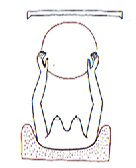 
 |
 |
|
manu kake |
Ga3-1 |
|
Kake.
Kakea,
to come near, to embark.
P Pau.: kake, to
climb, to ascend. Mgv.:
kake, the arrival
of shoals of spawning
fish. Mq.: kake,
to climb up a valley.
Ta.: ae, to
climb, to ascend.
Churchill.
Mgv.:
kake, to strike on
an ocean reef. Ta.:
ae, to strand.
Churchill. Sa.: a'e,
upward, to go up;
sa'e, to elevate one
leg, as in the act of
falling in a club match;
'a'e, to ascend,
to rise. To.: hake,
upward, to ascend. Fu.:
ake, up, to
ascend; sake, ro
raise the leg at one in
derision or mockery;
kake, to climb, to
ascend. Niuē:
hake,
up, going up. Uvea:
ake,
up; kake,
to go up. Ma.:
ake,
upward; kake,
to climb, to ascend.
Mq.: ake,
on high, upward;
kake,
to ascend. Mgv.:
ake,
upward. Bukabuka:
ake,
up. Ta.: ae,
up, to go up, to ascend,
to climb. Ha.:
ae,
to raise, to lift up, to
mount. Fotuna:
no-jikijiake,
to lift up;
no-tukake,
to stand upright.
Nukuoro: kake,
to go up. Nuguria:
kake,
up; hanage,
northwest. Rapanui:
kake a,
to go abroad. Vi.:
thake,
upward;
thaketa,
to dig or lift up.
Churchill 2. |
 |
 |
 |
 |
 |
|
Ga2-25 |
Ga2-26 |
Ga2-27 (57) |
Ga2-28 |
Ga2-29 |
 |
 |
 |
|
Ga3-1 |
Ga3-2 (61)
(aaa) |
Ga3-3 |
On one side of
the coint was Janus, at the
other side the Ship (Argo Navis) - or
rather as the joke (yoke) played
on the name of the American
astronaut Roger Chaffe with the
end coming first as
if seen in a mirror:
.jpg)
|
MAY 20 (140 = 80 + 60 ) |
 |
|
Ga3-1 (60) |
|
AL TARF (The End) = β Cancri
(124.3)
RAS ALGETHI (α Herculis)
|
|
July 23 (204) |
|
°July 19 (200 = 177 + 23) |
|
'June 26 (177 = 6 * 29½) |
|
"June 12 (163) |
|
CLOSE TO THE FULL MOON: |
|
NOV 19 (*60 + *183) (= 9 * 27) |
|
GREDI (Goat) = α Capricorni
(307.2),
σ Capricorni (307.5),
ALSHAT (Sheep) = ν Capricorni
(307.9) |
|
Jan 22 (387) |
|
°Jan
18 (384 = 360 + 24 = 13 * 29½ + ½) |
|
'Dec 26 (360 = 6 * 60) |
|
"Dec 12 (346) |
... Men's spirits were thought to dwell in
the Milky Way between incarnations. This
conception has been handed down as an Orphic
and Pythagorean tradition fitting into the
frame of the migration of the soul.
Macrobius, who has provided the broadest
report on the matter, has it that souls
ascend by way of Capricorn, and then, in
order to be reborn, descend again through
the 'Gate of Cancer' ...
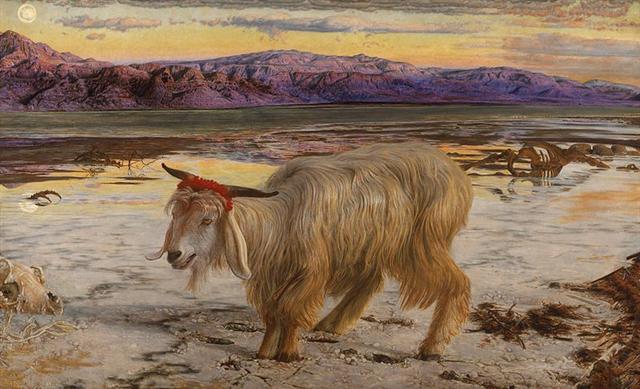
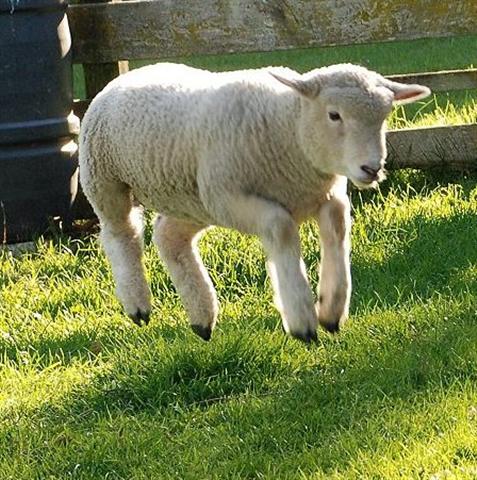
"... Some connect
the sign [Capricornus] in
Egyptian astronomy with Chnum,
Chnemu, Gnoum, or
Knum, the God of the
Waters, associated with the
rising of the Nile and worshiped
in Elephantine at the Cataracts,
this divinity bearing goat's,
not ram's, horns.
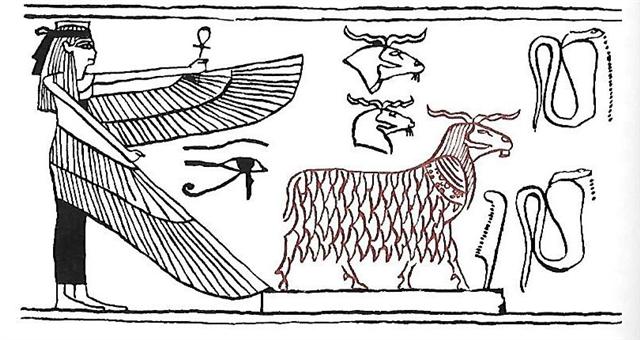
Others have said
that it was the goat-god
Mendes; and La Lande cited
the strange title Oxirinque
from the Greek adjective of a
Swordfish, our constellation
sometimes being thus shown, when
it was considered the cause of
the inundation. In Coptic Egypt
it was Όπέυτυσ,
Brachium Sacrificii; and
Miss Clerke says that it was
figured in that country as a
Mirror, emblematic of life
..." (Allen)
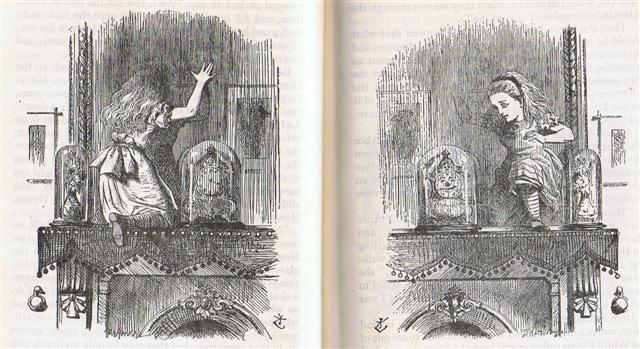
|











.jpg)



